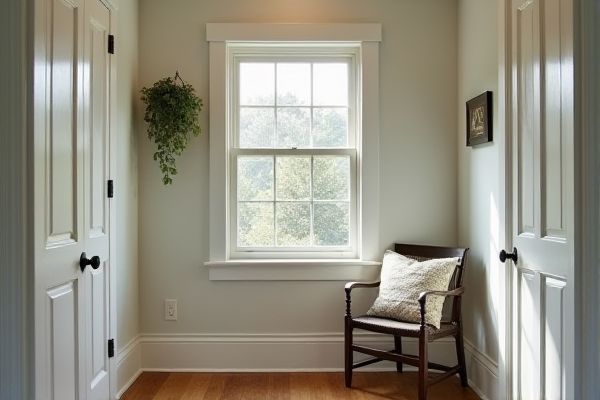
A mudroom window typically provides functional ventilation and natural light tailored for entryways, while a transom window is a decorative, horizontal window above doors or other windows that enhances architectural style and brightness. Explore the rest of the article to discover which option best suits your home's design and practical needs.
Table of Comparison
| Feature | Mudroom Window | Transom Window |
|---|---|---|
| Location | Typically installed at eye level in mudrooms | Located above doors or other windows |
| Purpose | Provides natural light and ventilation in mudrooms | Enhances light flow and architectural detail |
| Size | Larger, suited for room lighting | Smaller, narrow and wide often |
| Design | Varies: casement, sliding, or double-hung styles | Usually fixed or operable with a decorative frame |
| Functionality | Can open for air circulation | Mostly fixed, some operable for ventilation |
| Privacy | May have frosted or textured glass for privacy | Typically clear glass, less privacy concern |
| Installation | Installed flush in wall space of mudroom | Mounted above existing windows or doors |
| Cost | Moderate, depending on size and style | Generally lower due to smaller size |
Introduction to Mudroom Windows and Transoms
Mudroom windows are typically larger, providing natural light and ventilation while maintaining privacy and durability in high-traffic entry areas. Transom windows, positioned above doors or other windows, enhance brightness and architectural interest without compromising wall space or privacy. Both window types improve mudroom functionality by balancing light, air flow, and design aesthetics.
Key Differences Between Mudroom Windows and Transoms
Mudroom windows typically provide functional ventilation and natural light at a lower height, often designed to withstand moisture and dirt exposure. Transom windows are positioned above doors or other windows, primarily serving aesthetic purposes and enhancing natural light without offering operable ventilation. The key difference lies in their placement and functionality: mudroom windows focus on utility and durability, while transoms emphasize architectural design and light diffusion.
Benefits of Installing Mudroom Windows
Installing mudroom windows enhances natural light, improving visibility and creating a welcoming atmosphere in transitional spaces. These windows provide ventilation to reduce moisture and odors, promoting a cleaner, healthier environment. Strategically placed mudroom windows also increase energy efficiency by allowing passive solar heating and reducing the need for artificial lighting.
Advantages of Transom Windows in Mudrooms
Transom windows in mudrooms provide enhanced natural light without sacrificing privacy or wall space, making them ideal for small or narrow areas. Their elevated position allows for better ventilation and helps maintain a clean, organized look by keeping windows out of the way of storage and seating. Choosing a transom window can improve energy efficiency while adding architectural interest to your mudroom design.
Design Aesthetics: Mudroom Window vs Transom
Mudroom windows offer a large, practical design that enhances natural light and ventilation while providing a clear view, complementing the functional yet welcoming aesthetic of mudrooms. Transom windows, typically smaller and placed above doors or other windows, add architectural interest and classical elegance by allowing light to flow into adjoining spaces without sacrificing privacy. Both options enhance design aesthetics by balancing light and style, with mudroom windows emphasizing utility and openness, and transoms delivering refined detail and subtle illumination.
Natural Light Comparison: Mudroom Windows vs Transoms
Mudroom windows typically provide larger panes that allow more abundant natural light to enter, brightening the entire space effectively. Transom windows, positioned above doors or other windows, offer a more subtle influx of light, ideal for adding brightness without compromising privacy. Your choice depends on the desired light intensity and aesthetic; mudroom windows maximize daylight, while transoms enhance ambient light with architectural appeal.
Ventilation and Functionality Analysis
A mudroom window typically offers direct ventilation options, such as sliding or casement styles, allowing fresh air to circulate and reduce humidity, which is essential for drying wet footwear and clothing. In contrast, transom windows, positioned above doors or other windows, primarily enhance natural light but usually have limited or fixed ventilation capabilities, making them less effective for airflow control. Selecting a mudroom window over a transom improves functionality by promoting air exchange, reducing odors, and maintaining a dry, comfortable space conducive to mudroom activities.
Privacy Considerations for Mudroom Window Types
Mudroom windows require careful privacy consideration, with frosted or textured glass often used to obscure views while allowing light. Transom windows, placed higher on walls, offer natural light without compromising privacy due to their elevated position. Choosing window styles that balance daylight entry and privacy enhances mudroom functionality and security.
Cost and Installation Factors
Mudroom windows often cost less than transom windows due to their standard sizes and simpler installation requirements, making them a budget-friendly choice for most homes. Transom windows typically involve custom measurements and higher-end materials, which increase both the purchase price and labor costs during installation. Your project budget may benefit from choosing a mudroom window for straightforward fitting, while transom windows offer aesthetic appeal at a higher cost.
Choosing the Right Window Style for Your Mudroom
Selecting the right window style for your mudroom depends on your space and lighting needs. Mudroom windows provide larger panes for clear outdoor views and ample natural light, ideal for brightening the space and enhancing ventilation. Transom windows are smaller, often placed above doors, perfect for adding light while maintaining privacy and wall space for hooks or storage--you can maximize function without sacrificing design.
 homyna.com
homyna.com